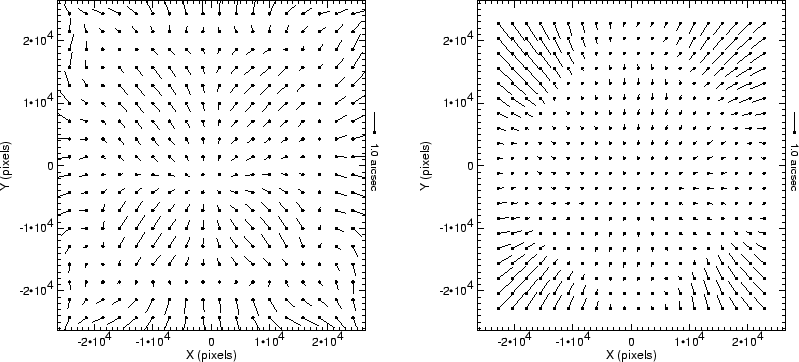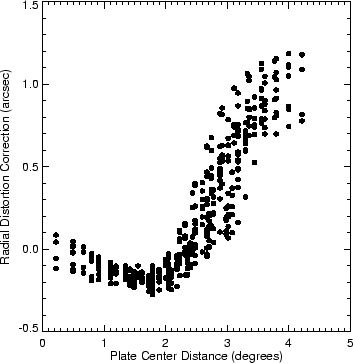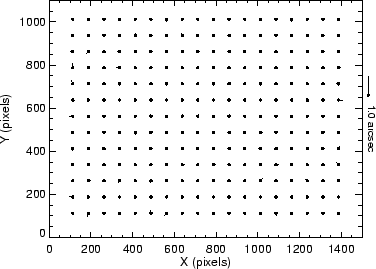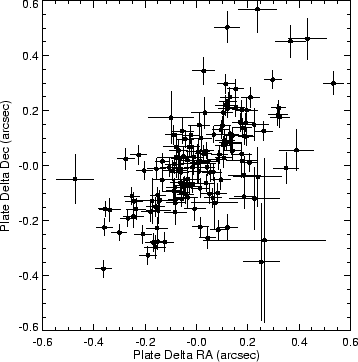As we show in WBHG, all unresolved FIRST sources down to the
survey limit have 90% confidence positional uncertainties of
![]() ; furthermore, the absolute reference frame is tied to the
VLB reference frame with an offset of
; furthermore, the absolute reference frame is tied to the
VLB reference frame with an offset of ![]() and an rms
uncertainty of
and an rms
uncertainty of ![]() in each coordinate. This level of
precision is unprecedented for such a high-surface-density catalog
(e.g., the Guide Star Catalog entries have an rms uncertainty of
0.4" with systematic errors of up to 1"), making FIRST a useful astrometric calibration standard for any astronomical
catalog which contains a significant number of FIRST source
counterparts. In this section, we use the radio source positions to
calibrate and correct the APM intraplate astrometry errors and the
plate-to-plate shifts, allowing an improvement by nearly an order of
magnitude in POSS-I positions.
in each coordinate. This level of
precision is unprecedented for such a high-surface-density catalog
(e.g., the Guide Star Catalog entries have an rms uncertainty of
0.4" with systematic errors of up to 1"), making FIRST a useful astrometric calibration standard for any astronomical
catalog which contains a significant number of FIRST source
counterparts. In this section, we use the radio source positions to
calibrate and correct the APM intraplate astrometry errors and the
plate-to-plate shifts, allowing an improvement by nearly an order of
magnitude in POSS-I positions.
The FIRST catalog contains about 90 sources deg![]() of which
of which
![]() 15% (see § 5.2) have APM optical counterparts within
15% (see § 5.2) have APM optical counterparts within
![]() , yielding
, yielding ![]() 600 matches per POSS-I plate. This,
in effect, provides a dense grid of astrometric standards across each
plate. More important, the optical counterparts to FIRST
sources are generally faint, and thus complement the astrometric
calibration that can be achieved using bright standards such as the
PPM and Tycho catalogs that have been used heretofore as the basis of
the APM plate solutions.
600 matches per POSS-I plate. This,
in effect, provides a dense grid of astrometric standards across each
plate. More important, the optical counterparts to FIRST
sources are generally faint, and thus complement the astrometric
calibration that can be achieved using bright standards such as the
PPM and Tycho catalogs that have been used heretofore as the basis of
the APM plate solutions.
Whilst working on radio identifications for the Jodrell Bank-VLA Astrometric Survey (JVAS - Patnaik et al. 1992; Hook et al. 1996; Snellen et al. 2001), it was noted that there was evidence for a shift between the mean Right Ascension and Declination of the APM reference frame and the VLA reference frame. The mean shift was derived by taking the median of the nearest optical counterparts to the survey's flat-spectrum radio emitters and yielded:
We verified that this effect was not intrinsic to the PPM reference frame
used for the APM plate solutions at that time by comparing
the optical positions of a set of VLBI Radio Reference Frame objects
(Johnston et al. 1995) with optical counterparts on APM scans and found
that the same systematic shift was present. We then remeasured POSS
field 1393 centered on the North Galactic Pole in two orientations: with the normal
scanning direction and with the plate rotated by 180 degrees. We found
that, after application of the original astrometric alignment using the
PPM stars, the derived positions for faint (![]() magnitude)
objects differed by
magnitude)
objects differed by
![]() in both coordinates. This
indicated that the APM measurement system was introducing a systematic
shift in the positions of bright objects with respect to fainter ones.
The origin of this effect is still under investigation. Our first step
in comparing FIRST sources and the APM catalog, then, was to
take out this systematic shift of 0.35" in both coordinates.
in both coordinates. This
indicated that the APM measurement system was introducing a systematic
shift in the positions of bright objects with respect to fainter ones.
The origin of this effect is still under investigation. Our first step
in comparing FIRST sources and the APM catalog, then, was to
take out this systematic shift of 0.35" in both coordinates.
The original POSS-I plates suffer from various distortions resulting from the stress induced by the plate holder, the vignetting of the 48-inch Schmidt telescope, etc., which are reproducible from plate to plate (Irwin 1994). In Figure 4(a), we display the pattern of residuals from the TYCHO reference stars derived by stacking the APM-TYCHO offsets for all such stars on 148 plates. Systematic errors reach 1.3" in some regions of the plate. A correction for this effect has, as noted above, been applied to all APM catalog positions using a correction map derived from the Tycho catalog.
 |
 |
We compared these corrected APM positions with those of FIRST
radio sources over the 148 POSS-I plates which subsume the current
survey region. Including all sources with optical counterparts having
offsets ![]() (
(![]() 60,000 objects with a false rate of
60,000 objects with a false rate of
![]() % -- see § 5) yields the result displayed in
Figure 4(b). Residuals within a radius of 2.5 deg of the
plate centers are substantially reduced compared with Fig. 4(a),
but large radial errors with
magnitudes up to 1.2" are now seen around the plate
edges (Fig. 5). We believe this effect is a consequence of a combination of
telescope vignetting and plate saturation of the bright stars in the
Tycho grid: vignetting distorts the stellar images in the radial
direction, producing elliptical isophotes whose centroids are
systematically shifted toward the plate center. The FIRST
counterparts, largely much fainter objects for which
saturation is not a problem, reveal this distortion.
% -- see § 5) yields the result displayed in
Figure 4(b). Residuals within a radius of 2.5 deg of the
plate centers are substantially reduced compared with Fig. 4(a),
but large radial errors with
magnitudes up to 1.2" are now seen around the plate
edges (Fig. 5). We believe this effect is a consequence of a combination of
telescope vignetting and plate saturation of the bright stars in the
Tycho grid: vignetting distorts the stellar images in the radial
direction, producing elliptical isophotes whose centroids are
systematically shifted toward the plate center. The FIRST
counterparts, largely much fainter objects for which
saturation is not a problem, reveal this distortion.
To correct for this effect, we have chosen to calibrate the errors
using all FIRST counterparts with
![]() ; the bright
limit is chosen such that the magnitude-dependent errors described
above will be unimportant (and only excludes 6% of the matches),
while the faint limit is imposed in order to include only those objects
for which the random errors are small. The correction proceeds
iteratively. We calculate a mean offset (in both the radial and
tangential directions) for all sources in the stacked image in cells
; the bright
limit is chosen such that the magnitude-dependent errors described
above will be unimportant (and only excludes 6% of the matches),
while the faint limit is imposed in order to include only those objects
for which the random errors are small. The correction proceeds
iteratively. We calculate a mean offset (in both the radial and
tangential directions) for all sources in the stacked image in cells
![]() on a side (20
on a side (20![]() 20 cells cover the plate). We then
apply the derived offsets to all APM objects in the catalog based on
their
20 cells cover the plate). We then
apply the derived offsets to all APM objects in the catalog based on
their ![]() -
-![]() plate positions, rematch to FIRST, and then
recalculate the mean offset for the cell. The process is repeated until
it converges (
plate positions, rematch to FIRST, and then
recalculate the mean offset for the cell. The process is repeated until
it converges (![]() 4 steps). An iterative approach is required
because the APM position shifts are comparable to the
4 steps). An iterative approach is required
because the APM position shifts are comparable to the ![]() APM-FIRST matching radius. The resulting APM-FIRST
position errors are much improved: the maximum residual mean offsets
are less than 0.18" with an rms of only 0.06" over the
whole plate.
APM-FIRST matching radius. The resulting APM-FIRST
position errors are much improved: the maximum residual mean offsets
are less than 0.18" with an rms of only 0.06" over the
whole plate.
This intraplate correction is strictly valid only for the range of
magnitudes used in the calibration (
![]() ). An examination
of the offsets for fainter counterparts suggests that the corrections work
well to the plate limit, although the positional uncertainties increase
slightly owing to the statistical fluctuations which are inevitable in
deriving positions for objects near the detection threshold. For the
brighter objects, however, the derived positions of candidate
counterparts to FIRST sources suffer from the same type of
distortion evident in the Tycho-based solution, presumably in a
magnitude-dependent way. Rather than attempting to derive the
functional form of the magnitude dependence from the small number of
bright FIRST counterparts, we recommend that for very bright
objects either the separation for an acceptable match be increased
or the offset be computed using
the APM astrometry without the FIRST astrometric correction.
For example, in the FIRST Bright Quasar Survey (White
et al. 2000) we
include all sources with optical matches closer than
). An examination
of the offsets for fainter counterparts suggests that the corrections work
well to the plate limit, although the positional uncertainties increase
slightly owing to the statistical fluctuations which are inevitable in
deriving positions for objects near the detection threshold. For the
brighter objects, however, the derived positions of candidate
counterparts to FIRST sources suffer from the same type of
distortion evident in the Tycho-based solution, presumably in a
magnitude-dependent way. Rather than attempting to derive the
functional form of the magnitude dependence from the small number of
bright FIRST counterparts, we recommend that for very bright
objects either the separation for an acceptable match be increased
or the offset be computed using
the APM astrometry without the FIRST astrometric correction.
For example, in the FIRST Bright Quasar Survey (White
et al. 2000) we
include all sources with optical matches closer than
![]() in
either astrometric frame, a procedure which adds 24 objects to
the 1214 selected using the FIRST astrometric solution alone.
Since the typical discrepancy between the two solutions is
in
either astrometric frame, a procedure which adds 24 objects to
the 1214 selected using the FIRST astrometric solution alone.
Since the typical discrepancy between the two solutions is
![]() and our minimum matching criterion is
and our minimum matching criterion is ![]() , no
genuine matches will be missed if this procedure is followed. However, since
the overwhelming majority of optical counterparts are faint, we have used only the
matches with the FIRST corrections applied when compiling the match
statistics in this paper.
, no
genuine matches will be missed if this procedure is followed. However, since
the overwhelming majority of optical counterparts are faint, we have used only the
matches with the FIRST corrections applied when compiling the match
statistics in this paper.
This use of FIRST sources as astrometric calibrators assumes,
of course, that there are no systematic errors in the radio positions.
In Figure 6, we display the analogous plot to
Figure 4(b) for the FIRST catalog: the ![]() -
-![]() positions of each FIRST source in the radio ``plate'' (i.e.,
coadded image -- see BWH) are extracted and the mean offset from the
APM matches to these sources (binned in
positions of each FIRST source in the radio ``plate'' (i.e.,
coadded image -- see BWH) are extracted and the mean offset from the
APM matches to these sources (binned in ![]() cells) is
calculated. The uniformity is excellent and the magnitude of the errors
is very small: they are all
cells) is
calculated. The uniformity is excellent and the magnitude of the errors
is very small: they are all ![]() with an rms of
0.05" over the whole field
with an rms of
0.05" over the whole field![]() . This result, coupled with our
global astrometric calibration described in WBHG suggests our
confidence in FIRST astrometry is justified, and that our radio
catalog can be utilized routinely to aid the astrometric calibration of
other catalogs.
. This result, coupled with our
global astrometric calibration described in WBHG suggests our
confidence in FIRST astrometry is justified, and that our radio
catalog can be utilized routinely to aid the astrometric calibration of
other catalogs.
 |
Having established the global APM offset and calibrated out the
reproducible intraplate errors, we are left only with translations of
individual plates with respect to our radio reference frame. The mean
FIRST-APM offsets for each of the 148 plates in the survey region are
shown in Figure 7. These offsets were computed using an
iterative approach similar to that used to derive the plate distortion.
There is no obvious trend with Right Ascension or Declination, but
shifts remain at levels ranging from 0.01" to
0.70"; the distribution of errors is roughly Gaussian in both
coordinates with an rms of
![]() and an apparent
tendency for large offsets in one coordinate to be matched by those in the
other. We remove these shifts by simply subtracting the shift
computed for a plate from the APM positions of all objects on the
plate. Note that for plates which fall completely within the boundaries
of the FIRST survey, this calibration is final; however, for
those plates only partially covered by the existing survey, the global
offset will be redetermined as new data accumulate. The size of any
subsequent correction is expected to be no more than
and an apparent
tendency for large offsets in one coordinate to be matched by those in the
other. We remove these shifts by simply subtracting the shift
computed for a plate from the APM positions of all objects on the
plate. Note that for plates which fall completely within the boundaries
of the FIRST survey, this calibration is final; however, for
those plates only partially covered by the existing survey, the global
offset will be redetermined as new data accumulate. The size of any
subsequent correction is expected to be no more than ![]() 0.1". The
current values, along with the intraplate correction matrix are available
on the FIRST Website.
0.1". The
current values, along with the intraplate correction matrix are available
on the FIRST Website.
 |
After correcting for the plate shifts, we have recomputed the
plate-based distortion maps (Fig. 4) to determine whether
the systematic plate shifts affect them. The changes in the
distortions are small (![]() ).
).
Having completed the astrometric calibration, we can now proceed to generate a catalog of optical identifications for the FIRST survey.